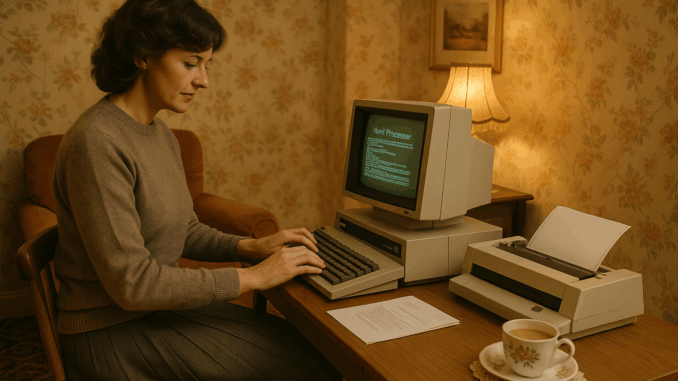
In the mid-1980s, if you walked into a British home with a computer in the corner, chances are you’d see a child loading Jet Set Willy or Chuckie Egg. But in more than a few households, you might have also caught their mum, gran, or even dad hunched over an Amstrad PCW or BBC Micro, carefully typing a club newsletter, crafting a family budget, or hammering out a draft of a family history. Word processing had arrived—not just in offices, but in our living rooms, spare bedrooms, and garden sheds. And with it came a quiet but powerful shift in who got to create, organise, and publish.
This wasn’t glamorous tech. These weren’t games or flashy demos. But for many people—especially older users, women returning to the workforce, and small business owners—word processors were tools of confidence and creativity.
The Typist Reborn
I recently restored a Canon Typestar 5 from a boot sale find—lightweight, thermal ribbon, and powered by AAs. It’s gloriously unremarkable. And yet, as I cleaned it up, I found a sheet still inside: part of a letter to a cousin in Canada, dated 1991. Simple. Personal. Powerful.
For many women trained on typewriters—often relegated to the typing pool—word processors represented freedom. No carbon paper, no correction fluid. Just clean, editable text and a sense that your skills still mattered. Amstrad’s PCW 8256, released in 1985, was a favourite in the UK home market. It came bundled with LocoScript and a built-in dot matrix printer, retailing as a complete word processing package aimed squarely at small business users and typists transitioning from traditional machines., bundled with LocoScript and a built-in dot matrix printer. It wasn’t flashy, but it worked. And for countless secretaries turned entrepreneurs or home-based clerks, it was a game-changer.
The Office in the Front Room
There’s a tendency to assume home computing was a teenager’s domain in the ’80s. But business software was readily available—Mini Office II, Fleet Street Publisher, and even Lotus 1-2-3 clones like GraphPlan and R.A.M. Plan, were among the software that brought spreadsheet and desktop publishing features to home systems. These applications mirrored professional office environments in miniature, accessible to anyone with a cassette loader or disk drive.. Parents used it for invoices, inventories, or writing up meeting minutes for school associations.
One reader shared her story of using a BBC Micro to run a catering company from home in 1986. “The word processor saved me from hiring a secretary I couldn’t afford,” she said. “I typed up menus, did accounts, even printed labels.”
These machines turned the lounge into an office. And while kids played Elite, their parents were quietly transforming domestic life into something surprisingly modern. In many cases, this also challenged traditional gender roles—mothers using tech not just for home management, but to grow businesses and assert financial independence.
Writing Ourselves into History
There’s something deeply human about these early word processor stories. They weren’t just about typing—they were about authoring. Diaries, family trees, speculative novels typed on daisy-wheel printers—most never published, but all full of intent. Software like Tasword (popular on the ZX Spectrum), Paperclip (a staple for the Commodore 64), and Protext (favoured on Amstrad and Acorn machines) made these projects accessible. They offered basic formatting, search functions, and file saving long before mainstream GUI word processors became household standards. to anyone with a keyboard and ambition.
Word processing democratised writing. Before this, most of us wrote by hand or pecked away on clunky typewriters. With computers, you could revise, reprint, and reshape. No publisher needed. No permission granted. If you had a computer and a printer, you could create. That alone made people feel seen.
Quiet Keys, Big Change
What’s striking about these machines is how quietly transformative they were. Unlike today’s flashy tech launches or disruptive apps, 1980s word processors simply gave people the means to get things done. In that simplicity lay power—especially for women, older users, and those building businesses from kitchen tables.
We often undervalue this kind of ‘quiet tech’—tools that organise, record, and express. But these were technologies of agency, especially for those who hadn’t been part of the previous computing narratives. They didn’t seek the spotlight. They created space.
And in many ways, we’re seeing echoes of that empowerment today. From zine culture and Substack newsletters to collaborative writing tools like Google Docs, the spirit of self-authored, home-spun publishing continues. Word processors didn’t just teach us to type. They taught us that what we had to say mattered.
We often remember the loud moments in tech history—the big reveals, the silicon revolutions. But word processors did their work quietly. In lounges and bedrooms, at kitchen tables and spare desks, they helped people communicate, dream, organise, and build.
They weren’t glamorous. But they mattered.
And sometimes, that’s the kind of computing history worth preserving most of all.

Leave a Reply